Succulents are excellent indoor plants. As long as they have a light, bright spot and you don’t overwater them, succulents are a low maintenance plants that purify the air and green up a living space. But where to start? There are thousands of types of succulents, so which are the best types of indoor succulents? Let’s take a look at some of the most popular succulents you can grow indoors.
What is a Succulent Plant?
But first, what exactly is a succulent?
Succulents are plants capable of retaining water in their leaves, roots, and stems. They have thick, fleshy leaves and thrive in arid conditions. The word succulent comes from the Latin sucus which means sap or juice and refers to the gel-type liquid found in their fleshy parts.
There are lots of succulent plants in different plant families, so “succulent” is an umbrella term for lots of plants, in fact cactus plants are succulents (but not all succulents are cacti!)
What Types of Indoor Succulents Are There?
There are many types of indoor succulents and a recent craze has led to succulent collectors trending on social media. Here are some of the most popular indoor succulents.
Jade plant (Crassula ovata)
Jade plant is a succulent sub-shrub that’s native to southern Africa. It has thick jade green leaves and a water-filled chunky stem. In winter it may throw up a stem topped with a star-shaped pink flower and its leaf margins may turn red.
Crassula ovata is very slow growing, so it’s a great indoor succulent for compact spaces. Plant breeders have crossed it with other species, so there are lots of jade plant cultivars to collect as well!
Traditional Chinese folklore says it brings good fortune and money, so jade plants are a popular housewarming and wedding gift.
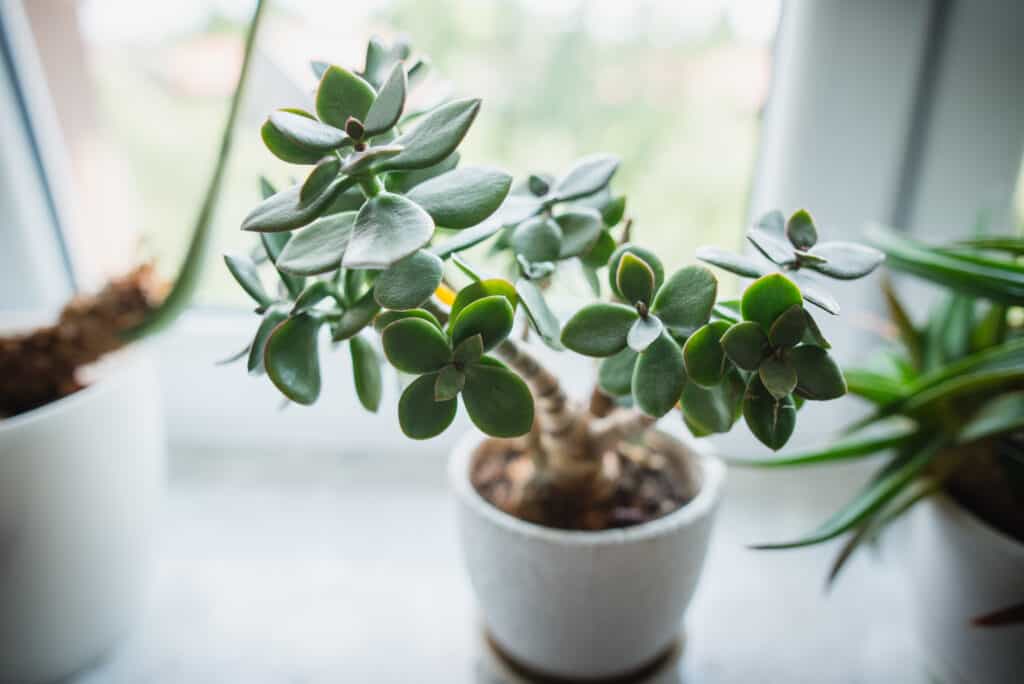
The jade plant (
Crassula ovata) has thick jade green leaves and a water-filled chunky stem.
©Jus_Ol/Shutterstock.com
Snake plant (Sansevieria trifasciata)
This indoor succulent has pointed sword-like fleshy leaves and can reach several feet in height without taking up much width.
There are several types, so the foliage color can vary, but all have pointed upright leaves that look very snake-like hence its common name, but snake plant is also known as mother-in-law’s tongue due to its sharpness.
NASA researched snake plants and found they are good air purifiers. This coupled with their virtually indestructible nature makes them excellent houseplants.
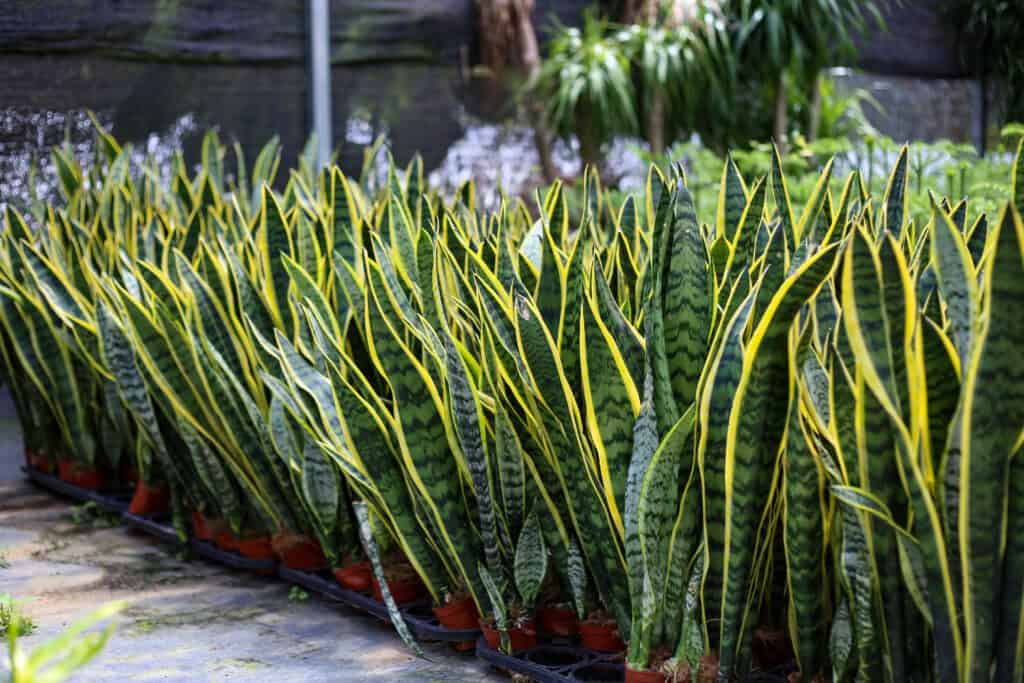
Snake plant (
Sansevieria trifasciata) is also known as mother-in-law’s tongue and has pointed upright leaves that look very snake-like.
©iStock.com/Joimi Joh Abi
Kalanchoe (Kalanchoe blossfeldiana)
These succulents are popular for their thick, glossy green leaves and bright flowers that bloom readily and without much intervention.
Kalanchoe blossfeldiana was discovered in Madagascar by Robert Blossfeld who modestly named it after himself, but it’s also known as flaming Katy or the panda plant no matter what shade its red, yellow, magenta, orange or white flowers are.
Many people throw them away when the flowers have faded, but they will flower again easily after a few months if you deadhead the blooms as they fade, give the plant plenty of indirect light, and water it infrequently.

is popular for their bright showy flowers and glossy leaves.
©iStock.com/Andrey Zhuravlev
Aloe vera
Perhaps the best known of the succulent plants due to its sunburn-relieving properties. It’s native to the Arabian peninsula, but has naturalized in many dry environments.
There’s very little clinical evidence that aloe vera gel is medicinal, but it has been used on skin problems for thousands of years, right back to the Ancient Greeks who applied it to battle wounds.
Aloe vera plants are stemless. The foliage grows straight from the soil in grey-green towers with soft spines. Because it’s so low maintenance, and safe around pets and kids, aloe vera is one of the most popular types of indoor succulents and there are many cultivars as a result.
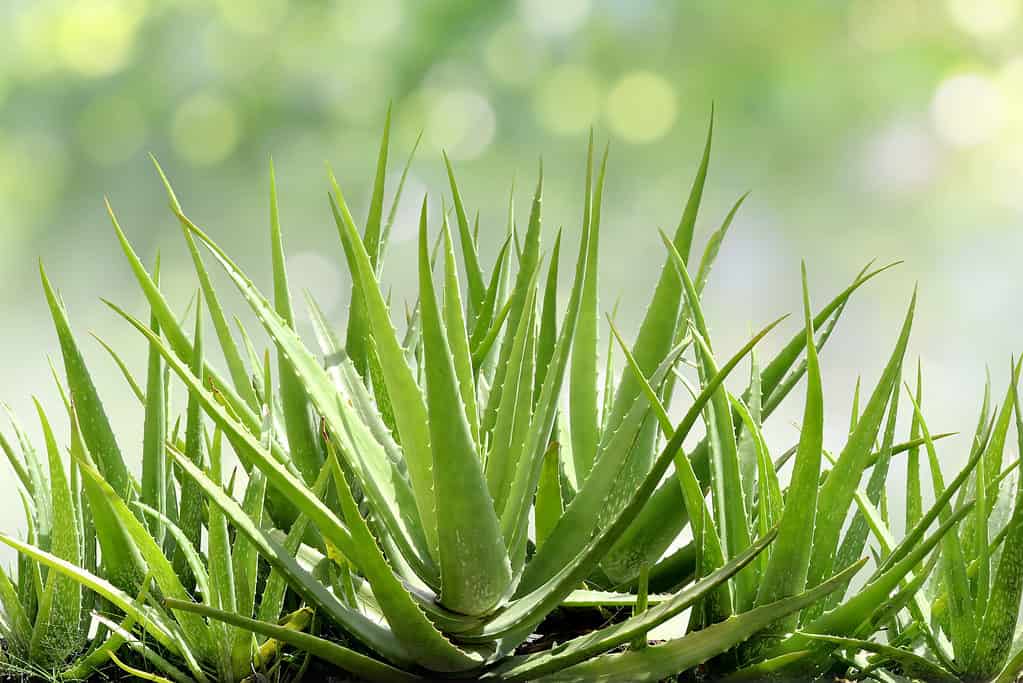
Aloe vera is one of the most popular types of indoor succulents because it is low maintenance and safe around dogs and kids.
©iStock.com/cgdeaw
Crown of thorns (Eurphorbia milii)
Also known as the Christ plant, Eurphorbia milii is usually grown outside, but it also makes an excellent houseplant in a sunny spot where it will grow to several feet in height.
It has thick bright green fleshy leaves and vivid red, yellow, orange or white flowers, but although it is very attractive, it has thorns and the sap is toxic.
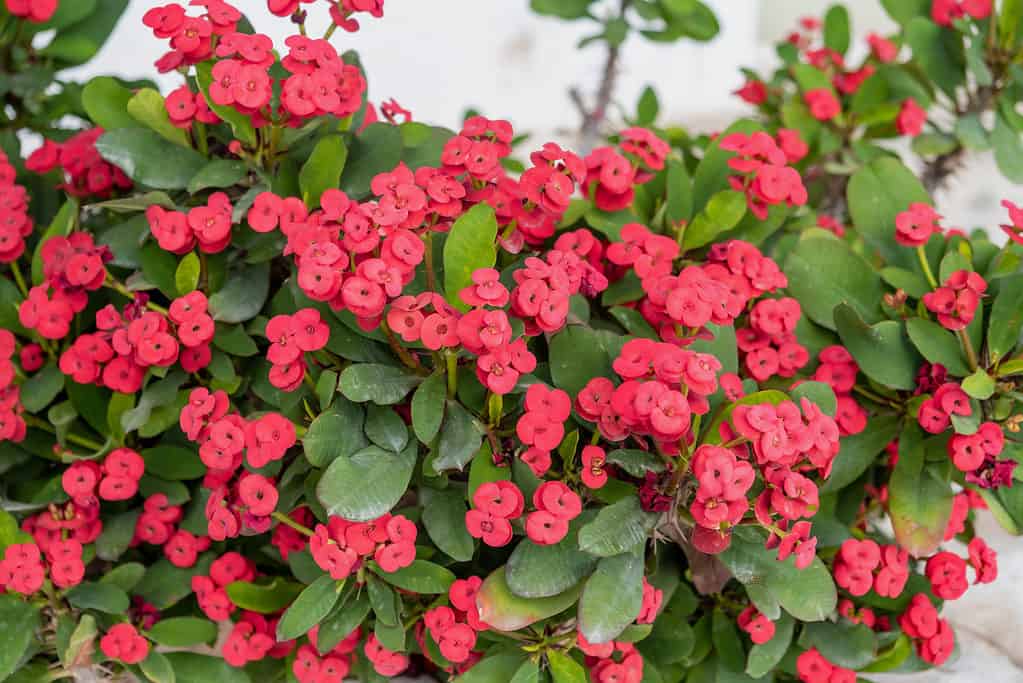
Crown of thorns (
Eurphorbia milii), also known as the Christ plant, has bright green leaves and vibrant flowers accompanied by thorns.
©iStock.com/Rawf8
Zebra cactus (Haworthia fasciata)
Zebra cactus is an easy-to-grow type of haworthia succulent with stripy upright foliage. It doesn’t get too big (max eight inches) and is one of the few succulents that can cope with lower light conditions.
If it’s happy it may flower in summer! Pinky-white flowers are borne on a 12-inch stem and they can last for months dancing above its striking zebra foliage.
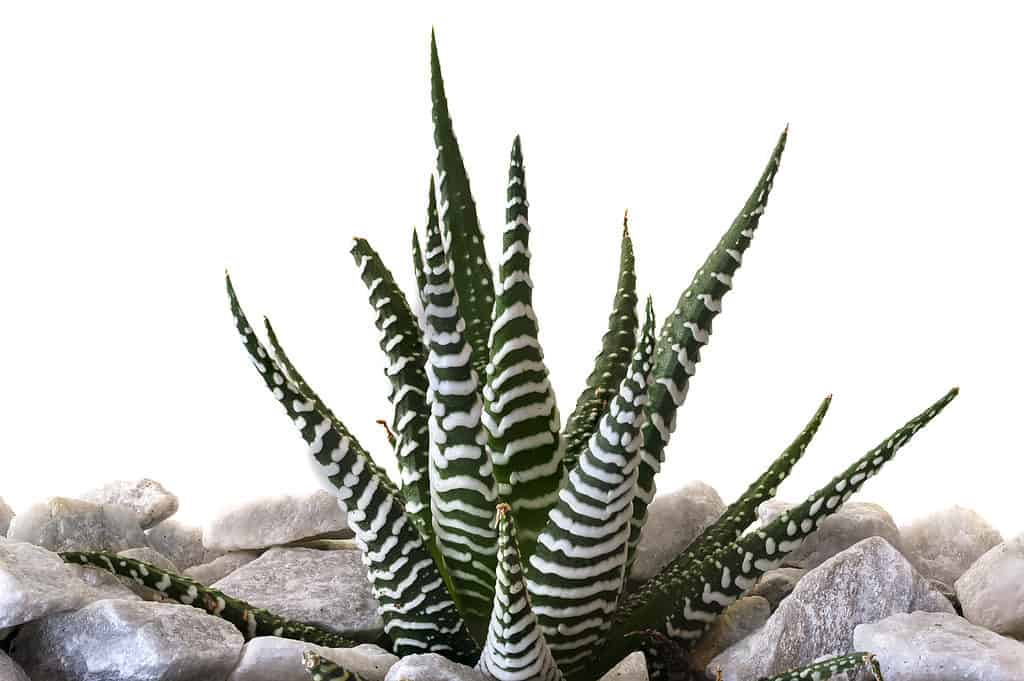
Zebra cactus (
Haworthia fasciata) is one of the few succulents that can cope with lower light conditions.
©iStock.com/RAUL RODRIGUEZ
Christmas cactus (Schlumbergera x buckleyi)
This is a succulent epiphytic perennial cactus that’s segmented and grows best in a high-sided container or hanging basket so its foliage can drape.
It’s a cultivated cross between two Brazilian species and was bred in England in 1850 by William Buckley. It has very little to do with Christmas other than its winter blooming flowers which can be white or red-pink.
Schlumbergera are incredibly tough types of indoor succulents that can cope without water for months on end (although this isn’t recommended!). It needs lots of sun in September in order to flower for Christmas.
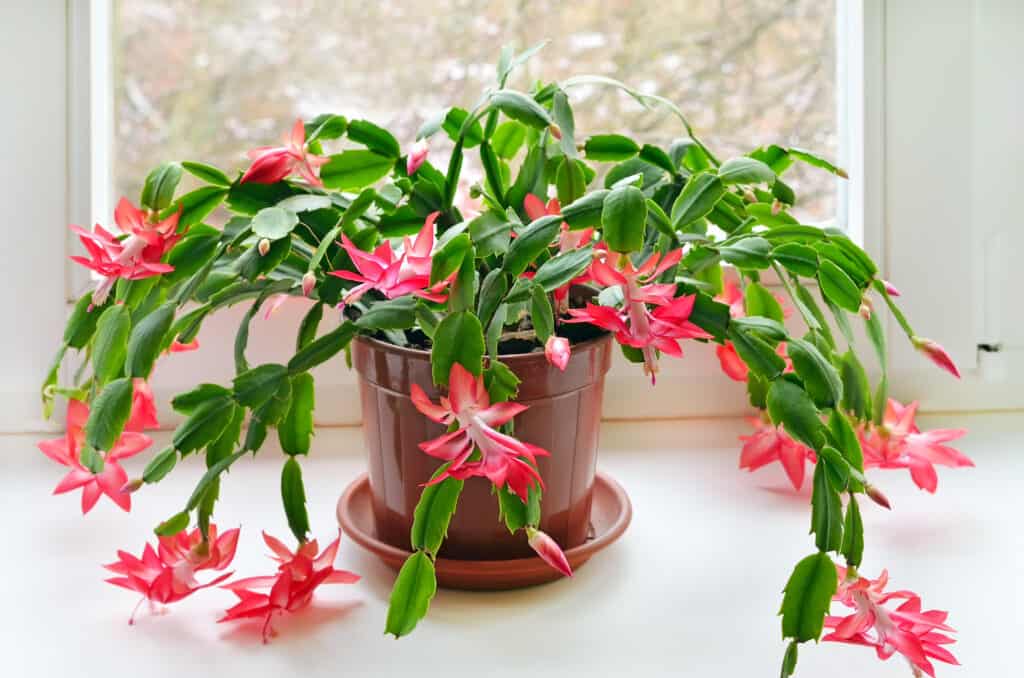
The Christmas cactus grows best in a high-sided container or hanging basket so its foliage can drape.
©iStock.com/Nadezhda_Nesterova
Why are Some Succulents Called “Indoors”?
The majority of succulents can be grown indoors, there are no specific indoor succulent types.
Generally, the smaller varieties are grown indoors, while tree and shrub succulents grow well in a dry, sunny yard. That said, there’s nothing stopping you growing any type of succulent indoors if you have a sunny spot with lots of room.
Are Indoor Succulents Poisonous to Dogs?
Some indoor succulents like the Crown of Thorns are poisonous but others such as aloe vera or hen and chicks are safe. The ASPCA collates a list of toxic plants here. If your cat or dog is a chewer, it’s safest to keep plants out of reach.
What is the Easiest Succulent to Grow Indoors?
Succulents are easy to grow, but perhaps the easiest are sempervivums, snake plants, and aloe vera. These succulents can tolerate long periods without water, they’re happy in mid to bright indirect light, and they don’t require any type of pruning.
How to Look After Succulents
Succulents need very little care; this is why they are such great indoor plants!
The majority of succulents need bright, indirect light. This can be a windowsill, desk, or coffee table in a sunny room, but be cautious of direct sun. Windows magnify sun rays, so whilst direct sun in the yard won’t hurt these succulents, the intense heat of a windowsill can scorch their foliage.
Water them sparingly (more on that later) and when it comes to fertilizer, they need very little. Once or twice a year in the growing season with a succulent-specific fertilizer is usually enough to keep an indoor succulent happy.
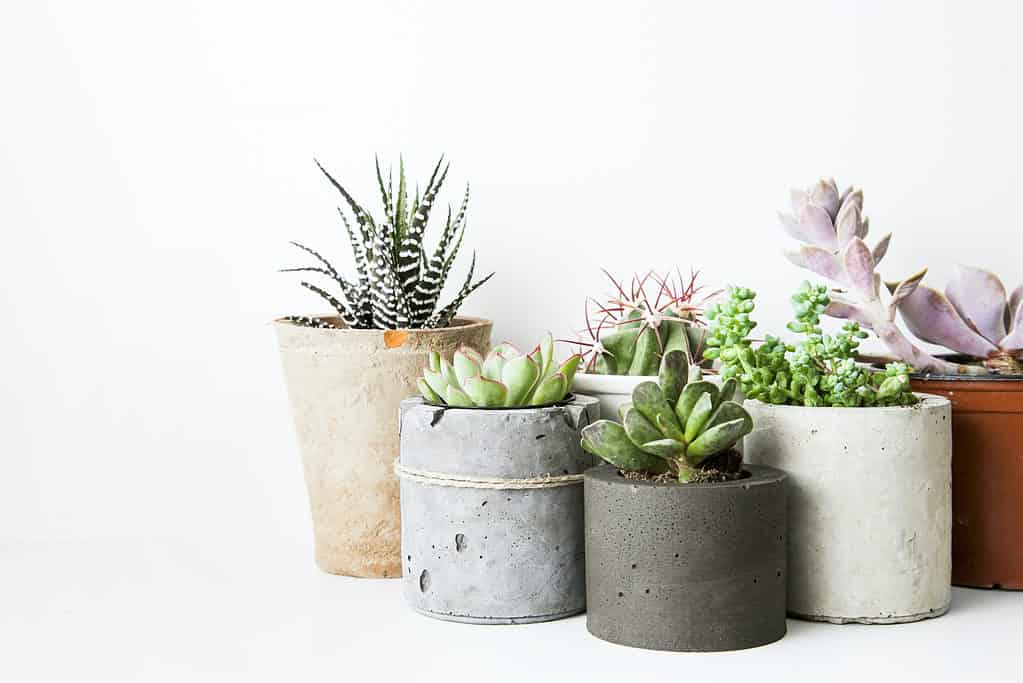
Succulents make for great indoor plants as they require minimal maintenance and thrive in indirect light.
©Julia Karo/Shutterstock.com
How Often Should You Water Indoor Succulents?
There are no set-in-stone rules when it comes to watering types of indoor succulents. It all depends on how much light they receive, how hot the central heating is, and the size of the plant.
In general, succulents need water when the soil has dried out on top, and it’s dry down to half an inch if you push your finger into the soil.
But wait! Don’t grab a watering can. When water settles in the foliage of a succulent it can cause rot. Instead, place your succulent plant in a shallow sink of water and leave it there to soak up water from the roots for a few hours.
When it’s time to dry off, leave indoor succulents on a draining board so their roots can run clear before replacing them on the windowsill.
Succulents left sitting in a container of soggy compost will rot. You know this has happened if its leaves turn brown or any kind of mushy foliage presents itself.
Types of Indoor Succulent: Which is Best?
There are so many types of indoor succulents, it’s impossible to choose a favorite. If you jump on Instagram you’ll quickly find succulent fan groups showing off their collections and singing the praises of their favorite indoor succulents.
Just choose the one you think looks good, give it a sunny home and go steady with its water supply. Soon you’ll soon have a happy thriving indoor succulent (or 10!) to purify the air and green up your living space with very little maintenance needed.
Up Next
- Are Succulents Poisonous To Dogs or Cats?
- Succulent vs Cactus: What’s the Difference?
- Burro’s Tail vs Donkey Tail: What’s the Difference?
The photo featured at the top of this post is © Daydreamr Digital Studio/Shutterstock.com
Sources
- ASPCA, Available here: https://www.aspca.org/news/are-succulents-safe-have-around-pets
- NASA, Available here: https://spinoff.nasa.gov/Spinoff2019/cg_7.html
- RHS, Available here: https://www.rhs.org.uk/plants/types/cacti-succulents/houseplants
Thank you for reading! Have some feedback for us? Contact the AZ Animals editorial team.






